· Todd Martin · Kitchen Appliances · 19 min read
Can I Use Over The Range Microwave As Countertop

Can You Use an Over-the-Range Microwave as a Countertop Unit?
We often face unique challenges in our kitchens. Maybe you are moving into a new place. Perhaps your current microwave stopped working. You might wonder, “Can I use over the range microwave as countertop?” It is a practical question for many homeowners. You might have an extra unit or need a temporary solution. Understanding the differences between these microwave types is important. This article will explore the compatibility. We will cover safety, ventilation, and practical considerations. Our goal is to help you decide if this setup works for your home.
Takeaway
- Physical Differences: Over-the-range (OTR) microwaves are heavier and larger. They have different vent systems and power cord locations.
- Safety Risks: Using an OTR unit on a countertop poses stability and ventilation risks. It may block vents or create fire hazards.
- Ventilation Issues: OTR units use top or rear vents. These vents can become blocked when placed on a countertop. Proper airflow is essential for safe operation.
- Temporary Use: Short-term use might be possible with extreme caution. Long-term use is not recommended due to safety and performance issues.
- Consider Alternatives: A dedicated countertop microwave or professional installation is safer. These options offer better performance and fewer risks.
Can I Use Over The Range Microwave As Countertop?
You can technically place an over-the-range (OTR) microwave on a countertop. However, it is not recommended for long-term use. OTR microwaves have different designs. Their ventilation systems and power cord placements are specific. These features are made for overhead installation. Using one on a countertop creates safety and functional challenges.
Understanding the Core Differences: OTR vs. Countertop Microwaves
Over-the-range (OTR) microwaves and countertop microwaves look similar. Their designs and functions differ significantly. These differences impact how they operate. They also affect how they should be installed. Knowing these distinctions is important for safe use.
Design and Installation Methods
OTR microwaves are large appliances. They mount above a stove. Their design integrates with kitchen cabinetry. These units often come with a mounting plate and bolts. The mounting hardware secures the microwave to the wall and upper cabinet. This ensures stability and proper alignment with the stove below.
Countertop microwaves are simpler. They sit directly on a flat surface. These units do not require special installation. You just plug them in. Their portability makes them easy to move or rearrange in a kitchen.
Ventilation Systems
A major difference lies in ventilation. OTR microwaves include a built-in exhaust fan. This fan pulls smoke, steam, and cooking odors from the stovetop. It can vent air outside or recirculate it back into the kitchen. The fan is typically located on the top or rear of the unit. These vents are crucial for kitchen air quality.
Countertop microwaves do not have external ventilation systems. They have small internal fans. These fans cool the internal components during operation. They do not remove cooking odors or steam from your kitchen. This difference means an OTR unit on a counter may not vent properly.
Power Cord and Electrical Requirements
OTR microwaves usually have a power cord coming from the top. This design allows for easy connection to an outlet hidden in the upper cabinet. Some OTR models are hardwired directly into a dedicated circuit. This ensures they receive enough power. Does an over-the-range microwave need its own circuit? Yes, they often do due to their high power draw.
Countertop microwaves have a power cord from the back. This cord plugs into a standard wall outlet. They typically require less power than OTR units. The placement of the OTR power cord can be awkward on a counter. It might hang unsightly or require an extension cord. This is not ideal for safety.
Weight and Stability
OTR microwaves are heavier than countertop models. They contain more robust components. These components include the powerful exhaust fan and internal structural supports. Their weight averages between 50 and 80 pounds. This weight helps them stay stable when mounted.
Countertop microwaves are lighter. They weigh between 20 and 40 pounds. Their design is for stable placement on a flat surface. An OTR unit on a countertop can feel top-heavy. Its feet are usually small or not designed for floor-level stability. This makes it more prone to tipping.
Understanding these differences shows why OTR units are specific. They are designed for overhead use. What does an over-the-range microwave look like? It has a distinctive appearance and features that separate it from a standard countertop model. For reliable performance and safety, a microwave should be used as intended. You can learn more about finding suitable options here: What is the best countertop microwave you can buy?
Key Safety Concerns When Using an OTR Microwave on a Countertop
Using an over-the-range (OTR) microwave on a countertop presents several safety issues. These concerns arise from the unit’s design. OTR units are made for overhead mounting. Placing them on a flat surface changes their intended use. This can lead to hazards.
Stability and Tipping Risk
OTR microwaves are heavy. They weigh more than standard countertop models. Their weight distribution is also different. OTR units are built to hang from above. They do not have wide, stable bases like countertop units. The feet on an OTR microwave are often small or poorly positioned for countertop use. This makes the unit prone to tipping over.
A tipping microwave can cause serious injury. It can also damage the unit or the countertop. If the door opens forcefully, the appliance might shift. A stable base is critical for any appliance you use daily. Without proper stability, accidents are more likely.
Restricted Airflow and Overheating
OTR microwaves have ventilation vents. These vents are typically on the top or rear. When mounted over a range, these vents have clear space. They can pull air effectively. Placing the unit on a countertop can block these vents. The countertop surface covers the bottom of the unit. Wall placement might block the rear vents.
Blocked vents lead to poor airflow. This causes the internal components to overheat. Overheating can damage the microwave. It also creates a fire hazard. A microwave needs proper cooling to operate safely. Without it, the appliance’s lifespan shortens. The risk of electrical malfunction increases significantly.
Electrical Hazards and Cord Management
The power cord for an OTR microwave usually exits from the top-rear. This design is for connecting to an outlet inside an upper cabinet. When placed on a countertop, the cord can be awkward. It may dangle over the edge. This creates a tripping hazard. It can also get caught or pulled. This might damage the cord or the outlet.
Using an extension cord is often necessary. This is especially true if the built-in cord is too short. Extension cords introduce additional risks. They can overheat if not rated for the microwave’s power draw. An overloaded circuit is also a concern. Why does my over the range microwave keep tripping the breaker? Improper electrical connections can lead to electrical fires or shocks. Always use a dedicated outlet for high-power appliances.
Functional Impairment and Appliance Damage
The exhaust fan on an OTR microwave will not work well on a countertop. Its position is wrong. It cannot efficiently draw air from a stove below. You might still hear the fan run. However, its effectiveness is greatly reduced. This means your kitchen will still collect smoke and odors.
Attempting to use the exhaust fan on a countertop can also harm the unit. The fan motor may overwork due to restricted airflow. This can lead to premature failure. The overall performance of the microwave also suffers. Heating unevenly or taking longer to cook food is common. This makes the appliance less useful and dependable. Always prioritize safety when setting up kitchen appliances.
Ventilation Challenges and Solutions for OTR Units on Countertops
Over-the-range (OTR) microwaves are designed with specific ventilation needs. These needs are tied to their overhead placement. Moving an OTR unit to a countertop creates significant ventilation challenges. Understanding these challenges helps you make informed decisions.
Understanding OTR Ventilation Systems
OTR microwaves use a powerful fan system. This system performs two main tasks. First, it extracts smoke and steam from the stovetop. Second, it cools the internal components of the microwave itself. Most OTR units offer multiple venting options:
- External Venting (Ducted): Air is drawn from the stovetop and pushed through a duct. This duct leads outside the home. This is the most effective way to remove odors and grease.
- Recirculating Venting (Ductless): Air is filtered and then released back into the kitchen. This option is used when external ducting is not possible. It helps with odors and grease but is less effective than external venting.
- Top or Rear Exhaust: The fan exhausts air from the top or rear of the unit. The specific vent location depends on the installation method.
When an OTR microwave sits on a countertop, these vent locations become problematic. The top or rear exhaust ports may be blocked. The countertop surface itself blocks the bottom airflow. This prevents the fan from operating as intended. How to install over the range microwave with vent? This article explains how these systems are typically set up.
Blocked Airflow and Overheating Risks
Placing an OTR microwave on a countertop can severely restrict airflow. If the unit uses a bottom intake for cooling, the counter blocks it. If it uses a top exhaust, placing items on top of the microwave can block it. A rear exhaust vent pressed against a wall or backsplash is also blocked.
Restricted airflow leads to overheating. The internal fan works harder to cool the magnetron and other components. This causes the motor to strain. It can also cause the unit to shut down unexpectedly. In severe cases, prolonged overheating can damage the microwave permanently. It also poses a fire risk. Heat buildup can degrade electrical insulation. This increases the chance of a short circuit.
Ineffective Fume Extraction
The primary purpose of an OTR microwave’s exhaust fan is to clear cooking fumes. When the unit is on a countertop, it is too low to effectively capture fumes from a stove. Smoke and steam rise. An OTR fan works best when positioned directly above the source.
On a counter, the fan becomes largely useless for kitchen ventilation. It will only pull air from its immediate surroundings. Your kitchen will still accumulate cooking odors and grease. This defeats a major benefit of having an OTR microwave. You might even find the fan blows hot air directly onto you. This happens if it cannot exhaust properly.
Solutions and Considerations
There are very few practical “solutions” for effective ventilation when using an OTR microwave on a countertop. Most attempts to mitigate the issue involve compromises that impact safety or performance.
- Elevating the Unit: You might consider placing the OTR microwave on a sturdy, open shelf on the countertop. This could provide some clearance for bottom vents. However, this increases the tipping risk. It also makes the unit even taller and more awkward.
- Ensuring Rear Clearance: If the unit has rear vents, ensure a significant gap between the microwave and the wall. This allows air to escape. Still, this does not solve the issue of the fan being too low for stove ventilation.
- Accepting Reduced Functionality: The most realistic “solution” is to accept that the ventilation feature will not work well. You would use the microwave solely for heating food. You would rely on other kitchen ventilation methods, like a separate range hood or opening windows.
Ultimately, using an OTR microwave on a countertop severely compromises its ventilation system. This impacts both the appliance’s safety and your kitchen’s air quality. It highlights why these units are purpose-built for overhead mounting.
Assessing Physical Stability and Countertop Requirements
The physical stability of an over-the-range (OTR) microwave is crucial. This is especially true if you plan to place it on a countertop. OTR units are heavy. Their design does not prioritize freestanding stability. Countertop requirements are also important for safety.
Weight Distribution and Footprint
OTR microwaves are designed to be secured to a wall and cabinet. This installation method distributes their weight. They typically weigh between 50 and 80 pounds. This is significantly more than a standard countertop microwave. Countertop models usually weigh 20-40 pounds.
The footprint of an OTR unit is often deep. This is to accommodate the exhaust fan mechanism. However, their feet are generally small. They are sometimes made of hard plastic. These small feet are not ideal for providing broad stability on a flat surface. They can also scratch delicate countertops.
When an OTR microwave is on a counter, its weight is concentrated on these small points. This makes the unit feel top-heavy. It becomes easier to tip forward or backward. A small bump can cause instability. This poses a hazard, especially in a busy kitchen.
Level Surface and Support
Any appliance placed on a countertop needs a level surface. An OTR microwave is no exception. An uneven counter can cause the microwave to wobble. This increases the risk of tipping. The countertop itself must be strong enough to support the heavy microwave. Most kitchen countertops can handle the weight. However, very thin or weak counter materials might be at risk over time.
It is also important to consider where you place the microwave. Avoid placing it near the edge of the counter. Keep it away from high-traffic areas. These locations increase the chance of accidental bumps. A stable, solid surface is fundamental for safe operation.
Vibration and Movement During Operation
Microwaves vibrate during use. This vibration comes from the magnetron and the turntable motor. OTR microwaves also have a powerful exhaust fan. This fan causes additional vibration. When these units are mounted overhead, the cabinet and wall absorb much of this movement.
On a countertop, these vibrations are transferred directly to the surface. A heavy, vibrating appliance on a smooth counter can slowly shift. It might creep towards the edge over time. This continuous movement can be annoying. More importantly, it creates a risk. The microwave could fall if it moves too close to the edge.
Solutions for Stability (Use with Caution)
While not ideal, some measures can improve stability for temporary use. Remember, these do not eliminate all risks.
- Rubber Mat: Place a non-slip rubber mat or silicone pad under the microwave. This can help prevent sliding. It also absorbs some vibration.
- Securing the Feet: If possible, try to add larger, non-slip rubber feet to the unit. Some OTR models have screw holes for feet. Make sure any additions do not block vents.
- Countertop Protection: Use a protective layer under the microwave. This prevents scratches or damage to your countertop. This is especially true for granite or quartz.
- Temporary Bracing: For very temporary situations, you might consider using books or blocks to brace the sides. This is not a long-term solution. It can look unsightly and still carries risks.
For long-term use, the lack of proper stability makes an OTR microwave a poor choice for a countertop. You can read more about temporary setups here: Can you use an over the range microwave on the counter temporarily? The article details the specific considerations for short-term use.
Electrical Considerations and Power Cord Placement
Electrical safety is paramount when using any appliance. This is especially true for high-power devices like microwaves. Over-the-range (OTR) microwaves have specific electrical requirements. Their power cord placement also differs from countertop models. Ignoring these differences can lead to hazards.
Power Requirements and Dedicated Circuits
OTR microwaves draw a lot of power. They typically require a dedicated 20-amp circuit. This circuit provides stable power. It prevents the microwave from overloading other appliances on the same circuit. Running an OTR microwave on a shared 15-amp circuit can cause problems. It might trip breakers frequently. It can also lead to overheating of the wiring. This creates a fire risk.
Standard wall outlets are usually on 15-amp circuits. These are fine for most countertop microwaves. However, they may not be adequate for an OTR unit. Before plugging in an OTR microwave, check your home’s electrical panel. Ensure the outlet is on a dedicated 20-amp circuit. If you are unsure, consult a qualified electrician. They can assess your electrical system.
Power Cord Location and Length
The power cord on an OTR microwave typically exits from the top or top-rear. This design makes sense for overhead installation. The cord can easily reach an outlet inside the upper cabinet. When the unit sits on a countertop, this cord placement becomes awkward.
- Dangling Cord: The cord may hang over the back or side of the microwave. This creates a tripping hazard. It can also get snagged.
- Limited Reach: The cord might be too short to reach a wall outlet without stretching. Stretching a cord can put strain on the outlet. It can also damage the cord over time.
- Blocking Vents: In some cases, the cord’s position might inadvertently block a rear ventilation port. This reduces airflow and increases overheating risks.
Avoiding Extension Cords and Adapters
It is generally not recommended to use extension cords with high-power appliances like microwaves. Extension cords can overheat if they are not rated for the appliance’s power draw. This is a fire hazard. If you absolutely must use one for temporary purposes, ensure it is a heavy-duty appliance cord. It must be rated for at least 20 amps.
Avoid using multi-outlet adapters or power strips. These devices are usually not designed for the sustained high power draw of a microwave. They can easily overheat and cause electrical problems. Always plug the microwave directly into a wall outlet. This outlet should be properly grounded.
Grounding and Safety Features
All modern microwaves are designed with three-prong plugs. This ensures proper grounding. Grounding protects against electrical shock in case of a fault. Never remove the grounding prong. Do not use ungrounded adapters. Ensure your wall outlet is also properly grounded.
Regularly inspect the power cord for any damage. Look for frayed wires, cuts, or scorch marks. If the cord is damaged, do not use the microwave. Have it repaired by a professional. These precautions help ensure safe operation.
Temporary vs. Permanent Setup: When is it Feasible?
The decision to use an over-the-range (OTR) microwave on a countertop depends on your needs. A temporary setup may be acceptable in specific situations. A permanent setup is generally not recommended. Understanding the differences helps you make a safe choice.
Temporary Use Scenarios
There are times when using an OTR microwave on a countertop might be your only option. These situations are usually short-term.
- During a Kitchen Renovation: Your kitchen might be under construction. Your main microwave might be unusable. An OTR unit can provide a temporary cooking solution. This allows you to heat food during the renovation period.
- Moving or Transition Period: You might be moving between homes. You might not have a permanent kitchen setup yet. An OTR microwave can serve as a stopgap. You can use it until your new appliances arrive.
- Emergency Situations: A sudden appliance breakdown might leave you without a microwave. If an OTR unit is readily available, it can help in an emergency. This is for a few days until you get a replacement.
In these temporary scenarios, extreme caution is necessary. Keep usage brief. Avoid heavy cooking. Monitor the unit closely for any signs of overheating. Ensure maximum possible ventilation. Recognize that this is not an ideal solution. Can you use an over the range microwave on the counter temporarily? This article explains the risks and precautions for short-term use.
Why Permanent Setup is Not Recommended
Using an OTR microwave as a permanent countertop fixture poses too many risks. The design flaws become significant over time.
- Safety Hazards: As discussed, stability is a major issue. The risk of tipping increases with frequent use. Electrical issues can also develop with prolonged improper cord management.
- Ineffective Ventilation: The fan will never perform well on a countertop. This means your kitchen will consistently have poor air quality. Grease and odors will build up. This affects comfort and cleanliness.
- Appliance Longevity: The constant strain from improper ventilation reduces the microwave’s lifespan. Overheating can damage internal components. This leads to costly repairs or premature replacement.
- Aesthetics and Ergonomics: An OTR microwave is large and bulky. It takes up significant counter space. Its height can also make it awkward to use on a counter. The door might open high, making it hard to reach inside. The power cord’s location also creates an eyesore. Can an over the range microwave be installed elsewhere? This question explores other unconventional installation options, but they also come with their own considerations.
Considering Your Appliance Needs
Before settling for a permanent countertop OTR setup, think about your appliance needs. If you need a microwave for everyday use, invest in a proper countertop model. These are designed for stability and efficient use on a counter. They come in various sizes and power levels. They also have appropriate venting for their design.
If space is a concern, consider a compact countertop microwave. Or, explore other built-in options. Does over the range microwave have to be over the range? The answer is no, not strictly, but it is the safest and most efficient place for it. Understanding these limitations helps you choose the best solution for your home. Prioritize safety and functionality for long-term satisfaction.
Alternatives to Using an OTR Microwave as a Countertop Unit
When you need a microwave, but an over-the-range (OTR) unit on your countertop is not ideal, consider alternatives. Several options provide better safety, functionality, and aesthetics. Choosing the right appliance for its intended use ensures a better experience.
Dedicated Countertop Microwaves
The most straightforward alternative is a standard countertop microwave. These appliances are designed specifically for use on a counter.
- Stability: They have wide, stable bases. Their weight distribution is balanced for flat surfaces. This reduces the risk of tipping.
- Ventilation: Countertop microwaves have internal cooling fans. These fans manage the unit’s temperature. They do not require external ventilation. This means no blocked vents or overheating issues from improper placement.
- Size and Power: They come in various sizes. You can find compact models for small kitchens. You can also find larger, high-power models. This allows you to choose one that fits your space and cooking needs.
- Cost-Effective: Countertop microwaves are generally less expensive than OTR units. This makes them an economical choice.
If you are looking for a new microwave, a dedicated countertop model is the safest and most practical choice. What is the best countertop microwave you can buy? This guide can help you find a suitable model.
- over range microwave
- countertop microwave
- microwave installation
- kitchen appliance safety
- temporary microwave use





